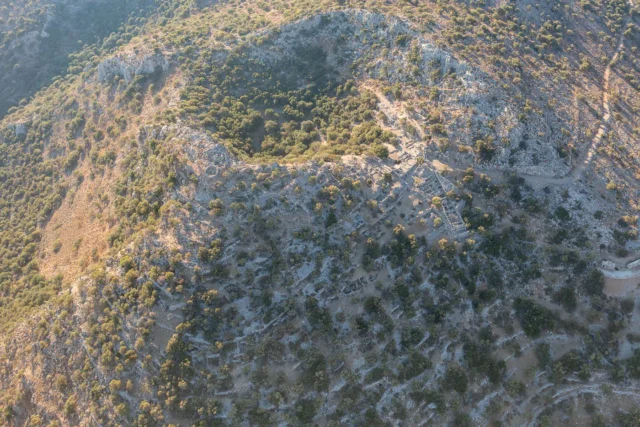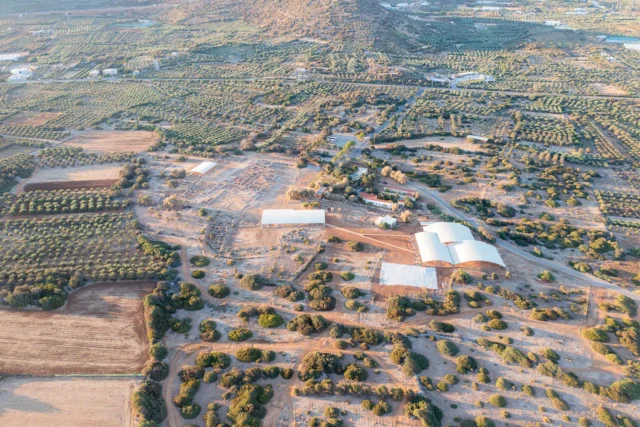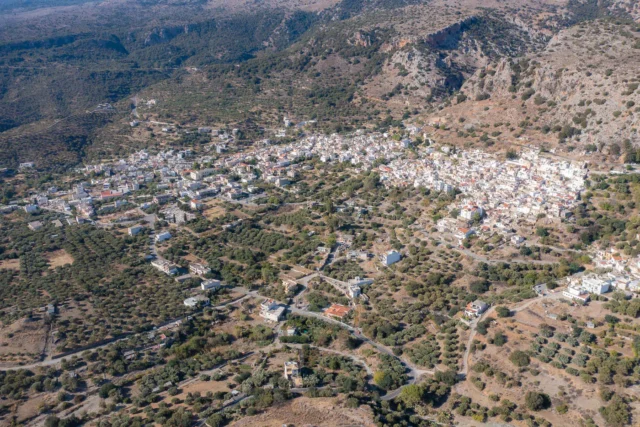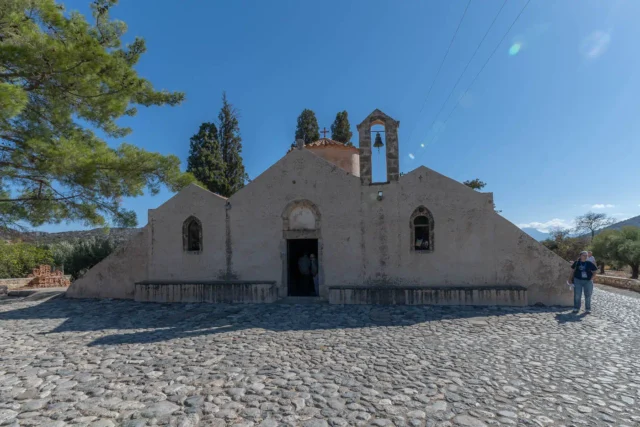Neapoli is a town in the Lasithi regional unit on the island of Crete, Greece. It is the historical seat of the Municipality of Agios Nikolaos and is situated in a valley known as “Skafi tou Merambelou” at an altitude of 270 meters. Neapoli lies on the road connecting Heraklion and Agios Nikolaos, 54 kilometers from Heraklion and 15 kilometers from Agios Nikolaos.
The town has a population of 2,773 inhabitants (2021 census). It serves as a local administrative center and has various amenities, including a courthouse, health center, pharmacy, police station, and post office. Neapoli is known for its historical significance, traditional architecture, and surrounding natural beauty.
History
-
Ancient Dreros: Two kilometers northeast of Neapoli, on Mount Kadestos, was the ancient city of Dreros. Founded in the 12th century BC, Dreros flourished from the Geometric to the Hellenistic periods until its destruction in 220 BC during a civil war. The city was rediscovered in 1855 with the finding of an inscribed stone, and systematic excavations took place in 1917 and 1932.
-
Venetian Period: During Venetian rule, a small village called “Kares” existed in the area of present-day Neapoli. Petros Philargos (or Philaretus), who became Pope Alexander V (1409-1410), was born in Kares in 1340. The Venetians destroyed Kares during the revolt of the Psaromilingoi in 1347, possibly due to a plague outbreak. They later rebuilt the village, which became known as “Kainourgio Chorio” (New Village). The 1583 census of Castrophylacas records it as “Chienurio Corio” with 1,272 inhabitants, making it the second-largest settlement in the Merambelo province after Kritsa.
-
Ottoman Period: Kainourgio Chorio thrived during the Ottoman period due to its location on the route between Heraklion and Lasithi. In 1868, it was designated the capital of the Lasithi region and renamed “Neapolis” (New City). Kostas Adosidis Pasha, an Ottoman Christian administrator, significantly reshaped Neapolis, changing the town plan and building administrative offices and a hospital. The first Gymnasium in the Lasithi region was also established in Neapolis. The town became the seat of the Metropolis of Petra.
-
20th Century: Neapolis remained the capital of Lasithi until 1904 when the administrative center was moved to Agios Nikolaos. Despite this, it continued to be an important commercial and intellectual center in the first half of the 20th century. However, after World War II and the German occupation, the town experienced economic decline and emigration.
Landmarks
- Megali Panagia: The largest church in Neapoli and the seat of the Metropolis of Petra and Cherronisos. It is a three-aisled basilica with a dome, built between 1888 and 1946.
- Church of Agios Pnevma (Holy Spirit): The only remaining part of a Venetian monastery in Neapoli, dating back to the 16th century.
- Church of Agios Georgios Platanias: A renovated church that was once part of a monastery founded in 1583.
- Church of Agios Georgios Psathas: A renovated church mentioned in a 1552 document.
- Venetian Churches: The renovated Venetian churches of Agios Spyridon (built in 1588) and Agios Stefanos (mentioned in 1546 documents).
- Church of the Metamorphosis tou Sotira (Transfiguration of the Savior) and Agios Pantes: A two-aisled church that served as the cemetery church of Neapoli, with frescoes dating from the 13th-14th centuries.
- Monastery of Panagia Koufi Petra: A women’s monastery located 5 kilometers south of Neapoli, founded in 1866.
- Monastery of Kremasta: A women’s monastery dedicated to the Archangels Michael and Gabriel, with a church dating back to 1593.
- Monastery of Fraros (Agios Antonios tou Simeti): A Latin Franciscan monastery with a church dating back to the second half of the 14th century.
- Paskaligo Forest: A forest named after the 16th-century Venetian feudal lord Fillipo Pasqualigo, with a variety of trees and endemic species.
- Tower of Masloum Karakasis: A Venetian-era tower built by Pasqualigo.
- Archaeological Collection: Housed in the former orphanage building, this collection contains artifacts from the region.
- Folklore Museum: Established in 1980, the Folklore Museum of PLEAM (Cultural Folklore Company of Ano Merambelo) showcases local traditions and history.
Village Key Points
- Historical References:
- 1387 document from the Ducal Archive of Chandax as “Chenuriogorio.”
- 1583 census of Castrophylacas as “Chienurio Corio” with 1,272 inhabitants.
- Location: Lasithi regional unit, Crete, Greece. 54 km from Heraklion, 15 km from Agios Nikolaos.
- Altitude: 270 meters
- Historical Significance: Ancient city of Dreros nearby, birthplace of Pope Alexander V, capital of Lasithi during the Ottoman period.
- Population:
Year |
Population |
|---|---|
1583 |
1272 |
1881 |
2288 |
2011 |
2683 |
2021 |
2773 |
- Current Status: Active town, historical and administrative center, known for its churches and monasteries, cultural events, and natural beauty.
Access
Neapoli is 12.4 kilometers away from Agios Nikolaos and 11.4 kilometers away from Kritsa

























There are no comments yet.